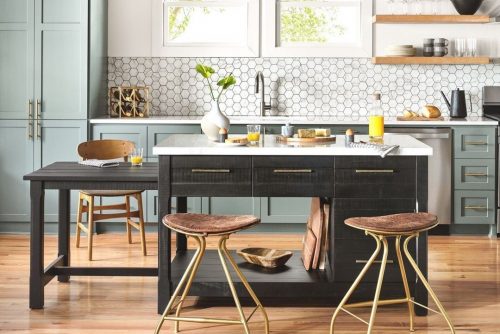Mixing Metals at Home: The Do’s and The Don’ts to Know

Oil and water. Cellphones and swimming pools. Toothpaste and orange juice. Some things just don’t mix well together, right? You may have heard this unfortunate design rumor about mixing metals, but it’s time to dispose of that outdated advice. Combining silver, gold, brass, or iron (just to name a few), is a great strategy for adding visual interest and depth to a space.
At the Kuotes, we always love textured, layered, eclectic spaces, and mixed metals is an effortless way to make the pieces in your home look like they’ve been collected over the years. When it comes to things that mix, mixing metals is the Reese’s Peanut Butter Cup of interior design… as long as you do it right. Here are the do’s and don’ts of mixing metals:
DO: Choose a Dominant Metal
Choose a metal you love to be the most prominent finish in your space, then select one or two metal accents to complete the look. For example, if your kitchen hardware is in an oil-brushed bronze, copper pots and accent pieces will add a warm glow. If you have a modern, stainless steel kitchen, choosing a chandelier or vintage piece with silver or gold can add charm and texture. Or if you love the “gold and white” look, add in a chrome table or pendant light for metallic balance.
DON’T: Be Afraid of Mixing Warm and Cool Tones
Warm metals (like gold, brass, and nickel) read as a rich pop of color and texture when placed with cool metals like silver and chrome. Many people think that matching your finishes is the best way to coordinate your home or kitchen, but in reality this often creates a monochromatic and dated look.
We often get questions about which metals work best together, and the answer is: They all can go together…as long as there is clear design intent! Metals are meant to be mixed, so don’t worry too much about whether they’ll “go together” and instead make sure each finish is a thoughtful addition to your space. That being said, if you have several metallic tones that look very similar but not identical, it’ll look like a mistake. Contrast is key!
DO: Consider Your Color Palette
Although we encourage mixing and matching, it is very important to consider your color palette when selecting the metals for your space. Typically, you should use warm metals (like brass, nickel and copper) with warm hues (like whites, beiges, browns and taupes) and cool metals (such as chrome and silver) with cool hues (such as blues, greens and grays).
It is neutral rooms, however, that beg the most for metallic accents in order to add warmth, texture, and color. For example, if you’re using a lot of grey colors, a gold mirror can make your room come to life. Use your metals to even out your room temperature!
DON’T: Disregard Texture When Mixing Metals
When using metals, don’t forget to consider texture. Texture can make all of the different in a space with mixed metals. Combine matte, polished, and hammered finishes to create a visually rich atmosphere.
Do: Use Natural Iron As a Neutral
Iron is the neutral of the metallic world. It is a modern industrial touch that adds a dark element to a palette that needs to be grounded or toned down. It won’t clash with other metal tones, and it also highlights warmer metals, such as gold and brass, as a strong pop of color.
DO: Keep It Subtle
Look at the photo above. Even though we have silver and gold here, the two metals never compete for attention. The mixed metals also add dynamic to a room that’s otherwise perfectly symmetrical and matching (the gold table legs even match the pattern of the carpet).
DON’T: Put the Pedal to the Metal
Play around with the metal in your home, but don’t go overboard. Our guideline? Stick to two finishes. There’s a potential for three is there’s a statement piece of some kind, or if the metals are spread across a large space, but ideally you want two metals, a prominent tone and an accent.
See more at…https://www.kathykuohome.com/blog/mixing-metals-the-dos-and-donts/